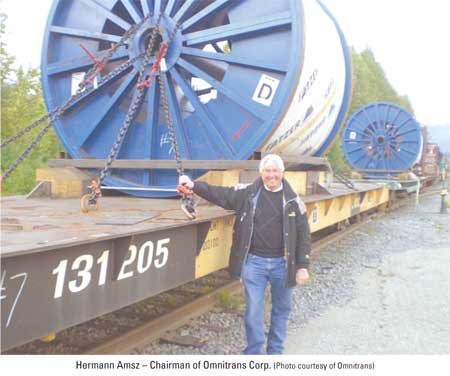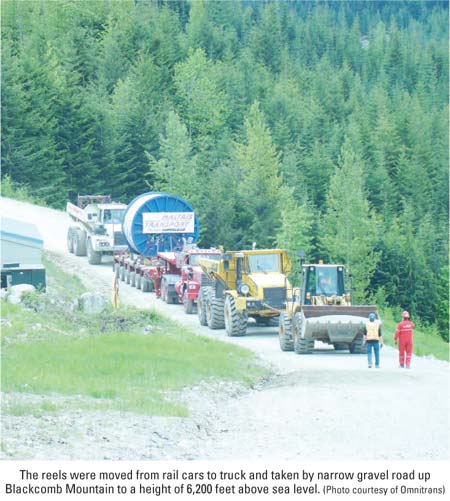Moving cable to mountain top the ‘biggest triumph’ for Omnitrans’ ChairmanOrganizers for the 2010 Winter Olympics, to be held in Vancouver, BC, and the ski resort of Whistler, are striving for the spectacular, and they seem to have found it with a gondola ride that will stretch from the top of Whistler Mountain to the top of neighboring Blackcomb Mountain.
By Leo Quigley, AJOTScheduled for completion in December 2008, the “Peak 2 Peak” gondola will cost roughly C$50 million and will be capable of transporting 4,100 people an hour in cars that run every minute and feature glass floors to allow passengers to appreciate the mountain view. Lasting 11-minutes, the four-kilometer journey between the mountains will lift passengers 436 meters above Whistler village.
Billed as the longest unsupported cable system in the world, the tramway will travel along especially made cables that are now being strung by helicopter between the two mountain tops in the Rocky Mountains, after having been moved to the site by New York-based Omnitrans Corp.
It was an assignment that Hermann Amsz, Chairman of Omnitrans Corp. said was one of the most complex moves in his 50 plus years experience handling difficult logistical problems.

“I babied this project from the beginning to the end, all the way up to Blackcomb Mountain at 6,000 feet,” Amsz said. “Including the two black bears that greeted us like they were the welcoming committee.”
The five gondola cable reels were brought from Switzerland by barge to the Netherlands across the Atlantic and through the Panama Canal on the Star Indiana, owned by Star Shipping of Norway. They were then unloaded at the Port of Vancouver, Washington, which owns the largest mobile harbor crane in North America, a Liebherr LHM500 capable of lifting 140 metric tons, onto BNSF flatcars.
The specialized move included four reels of track ropes, each weighing approximately 90 metric tons, and one smaller reel of haul rope, weighing more than 80 metric tons. The cables - a total of 27 kilometers in length - were built by Fatzer, a Swiss company based in Romanshorn that develops, manufactures and markets high-quality wire ropes.
The logistics involved included a barge trip from Basil Rhine River Port in Switzerland to Vlissingen, a key port in Southwestern Netherlands. The reels then traveled across the Atlantic Ocean and through the Panama Canal on the Star Indiana to Vancouver, WA. There, the cable was offloaded onto a BNSF train and moved north along the Pacific Coast to New Westminster, near the city of Vancouver, Canada. There, the reels were handed off to Canadian National Railway and taken north into the Rocky Mountains and the ski resort of Whistler; where they were moved from the rail cars to truck at Mons siding and taken by narrow gravel road up Blackcomb Mountain to a height of 6,200 feet above sea level.

In order to move the 90-ton reels, a German-made Goldhofer heavy-haulage trailer and tractor brought in from Montreal was used. The specialized trailer was equipped four sections with six axles each and eight wheels to each axle.
“The truck has a sliding system that eliminates the use of a crane,” Amsz said. “But, before that, we had to move a lot of dirt to make the area next to the track level with the rail.
“It was then that we found out that there were two gas pipelines four feet below the ground and parallel to the tracks. So, we had the engineering group from Terasen Gas give us their recommendation as to what we had to do.
“We had to rent some steel plates and make two berms and put the plates over the berms so we had a bridge over the pipelines,” he said.
Once loaded onto the truck the reels were taken up the gravel supply road to the top of the mountain. Amsz said some stretches of the roa



